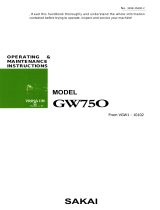
wc_bo5100026248_03TOC.fm 0-7
7 Maintenance
7.1 Maintenance Overview ........................................................................................................................ 145
7.2 Lubrication Plan ................................................................................................................................... 150
7.3 Engine Oil Viscosity ............................................................................................................................. 151
7.4 Priming the Fuel System ..................................................................................................................... 152
7.5 Checking Engine Oil ............................................................................................................................ 153
7.6 Changing the Engine Oil and Filter ...................................................................................................... 155
7.7 Hydraulic Oil Requirements ................................................................................................................. 157
7.8 Hydraulic Oil Specification ................................................................................................................... 157
7.9 Checking the Hydraulic Oil Level ......................................................................................................... 158
7.10 Checking and Adding Engine Coolant ................................................................................................. 159
7.11 Servicing the Air Cleaner ..................................................................................................................... 160
7.12 Cleaning the Radiator, Charge Air Cooler, and Oil Cooler .................................................................. 161
7.13 Maintaining the Fuel Filter and Water Separator ................................................................................. 162
7.14 Checking for Leaks .............................................................................................................................. 163
7.15 Inspecting and Repairing the Cab ....................................................................................................... 164
7.16 Maintaining the Seat and Seat Belt ..................................................................................................... 164
7.17 Fuse and Relay Box Layout—Cab (Tier III) ......................................................................................... 165
7.18 Fuse and Relay Box Layout—Cab (Tier IV) ........................................................................................ 166
7.19 Fuse and Relay Box Layout—Engine (Tier III) .................................................................................... 167
7.20 Fuse and Relay Box Layout—Engine (Tier IV) .................................................................................... 168
7.21 Fuse / Relay Box Layout—14-Pin (Tier III and Tier IV) ....................................................................... 169
7.22 Cab Front Door Switch ........................................................................................................................ 170
7.23 Testing the Control Interlock System ................................................................................................... 171
7.24 Locking the Rear Door ......................................................................................................................... 172
7.25 Cleaning the Outside of the Side Window ........................................................................................... 173
7.26 Removing and Installing the Side Windows ......................................................................................... 174
7.27 Servicing the Front Window Washer ................................................................................................... 175
7.28 Cleaning the Front Door Window ......................................................................................................... 175
7.29 Joystick and Lever Maintenance ......................................................................................................... 176
7.30 Replacing the HVAC Filter ................................................................................................................... 177
7.31 Cleaning the Air Conditioner Condenser ............................................................................................. 178
7.32 Changing the Dome Light Bulb ............................................................................................................ 179
7.33 Changing Work Light Bulbs ................................................................................................................. 180
7.34 Testing the Backup Alarm ................................................................................................................... 181
7.35 Checking and Adjusting Track Tension (ST28 / ST31) ........................................................................ 182
7.36 Final Drive System .............................................................................................................................. 184
7.37 Maintenance for Attachments .............................................................................................................. 186
7.38 Engine—Jump-Starting ....................................................................................................................... 186
7.39 Maintaining the Battery ........................................................................................................................ 188
7.40 Cleaning the Machine .......................................................................................................................... 190
7.41 Long-Term Storage .........................................................................................................
.................... 191
7.42 Machine Disposal and Decommissioning ............................................................................................ 192
8 Troubleshooting
8.1 Engine Warning Lights (Tier IV) ........................................................................................................... 193
8.2 Engine and Engine-Oil Warning Lights (Tier IV) .................................................................................. 194
8.3 Warning Lights (Display Element / Instrument Display) .......................................................................195
8.4 General Machine Troubleshooting ...................................................................................................... 196






















